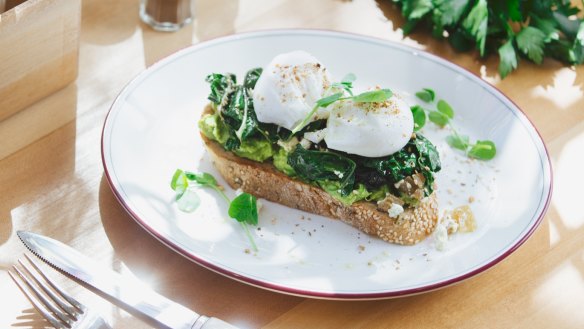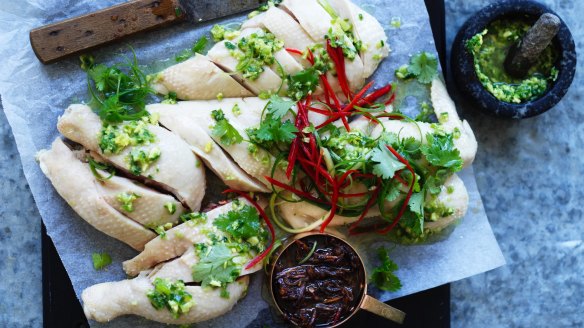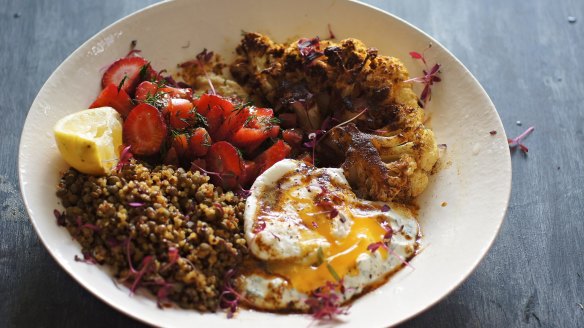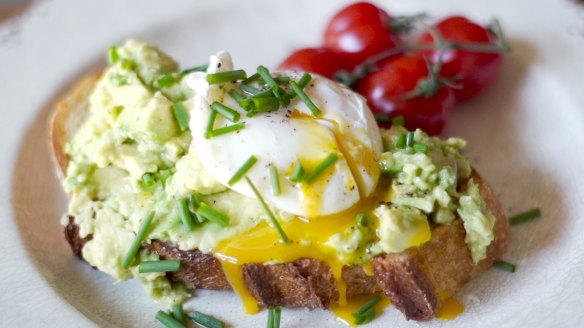Don't know how to poach foods? It's worth learning

- Kylie Kwong's poached chicken recipe
- Video: Jill Dupleix's guide to perfect poached eggs
- Katrina Meynink's Turkish poached egg, spiced cauliflower, hummus and lentil-quinoa salad
As has happened before, my family is feeling uninspired by our regular weeknight dinners. While stuck in past ruts, we experimented with sheet pan dinners until our favourites shook out. We mastered the perfect rice bowl and conquered the slow cooker, taking a handful of new recipes for our own. Is there yet another cooking technique that could reinspire our weeknight meals?
Yes, there is. It is a technique that is as old as the ages, one that requires few dishes, no equipment other than a stove, and is as healthy as can be.

What exactly is poaching?
To poach is to slowly simmer food in liquid until it is cooked. It is a very gentle and gradual way to cook, fitting for delicate foods such as eggs, fish and fruit. Poaching allows the protein in the food to cook without losing moisture. In contrast, if a chicken breast were dropped into a pot of boiling water, the protein molecules would quickly seize and the moisture would be squeezed out. The end result would be a dry, rubbery piece of meat. Grilled chicken can sometimes turn out a bit dry for the same reason; the grill is very hot when the chicken lands on it, so moisture is lost.
Poaching liquid can be as simple as water, as hearty as a broth or even an oil. An acid such as wine, lemon juice or vinegar is usually added to the poaching liquid to help the protein set quickly. To add flavour, include a mix of herbs, garlic and peppercorns, and if you want to be an overachieving poacher, add onion, celery and carrot. Fruits are usually poached in wine and water, with aromatic spices such as cloves and cinnamon.

Foods do not brown when they are poached, so the finished product will be very pale and uniform in colour. This can be quite pretty in some cases - the pure white and bright yellow egg or the stark white chicken breast in a chicken salad - but a poached white fish may appear less appealing than the one that is golden brown from the oven.
Poaching is ideal for foods that are going to be cooked or used again. I often poach chicken ahead of time and then shred it for chicken salad, enchiladas that will be baked in the oven or an Indian chicken dish that will be cooked on the stove-top. It is convenient to have the meat already cooked and ready to shred when I start dinner.
Poached foods have earned the reputation of being diet foods because when poached in water, there isn't any added fat. We know that certain fats such as olive oil are good for us, but many other cooking techniques use less healthful fats and oils, or too much fat during the cooking process. I poach so I can limit unhealthy fats or incorporate healthy ones such as when poaching in bone broth. I also love this technique because it results in great-tasting, moisture-filled foods.

Because eggs are such a great way to add protein to any dish, we have been topping salads, grain bowls such as bibimbap, pasta, soups and toast with poached eggs.
The fresher the egg, the better it will poach. Older eggs often produce "legs" or strings from the egg white. To poach more than one egg at a time, be sure your pan is large enough to accommodate them. Crack each egg into its own measuring cup, and increase the cooking time by 30 seconds for each additional egg you add.
- Combine 3 inches of water and a splash of distilled white vinegar in a saucepan, over medium-low heat, so the liquid reaches a temperature of 170 degrees, or until there are tiny bubbles along the bottom of the pan but they are not rising to the top and breaking.
- Crack an egg into a metal or heatproof measuring cup. Lower the cup into the water in the center of the pan. Tip the cup so the egg gently slides into the water.
- Cook for 4 to 5 minutes, until the egg white is fairly firm but the yolk is still movable, or longer if you like the yolk a little firmer. Use a slotted spoon to transfer the egg to paper towels to drain. Season lightly with salt and pepper.
- Serve atop a salad, a grain bowl, toast, pasta or soup.
Poaching chicken breast
These are ideal for slicing or shredding. When they are bone-in, they'll take longer to cook.
- Arrange 4 boneless, skinless chicken breast halves (without tenderloins attached) at the bottom of a 2- to 4-quart pot. Season lightly with salt; add aromatics such as fresh herbs, peppercorns, smashed garlic cloves, sliced fresh ginger and/or thinly sliced onion. Pour 1 cup of dry white wine over the chicken; this will help the meat stay moist in the end. Add enough cool water to cover the chicken by 1 inch.
- Bring the mixture to a boil over medium-high heat, then immediately reduce the heat to medium-low, so the liquid is barely bubbling at the edges. Cover and cook for 8 to 14 minutes, depending on the size of the chicken breasts. An instant-read thermometer inserted into the thickest part of the meat should register 165 degrees, or you can use the tip of a sharp knife to poke in and see that the breast meat is opaque all the way through.
- Use tongs to transfer the chicken to a cutting board or plate; discard the liquid. Serve hot or let cool.
The Washington Post
The best recipes from Australia's leading chefs straight to your inbox.
Sign up- More:
- How to